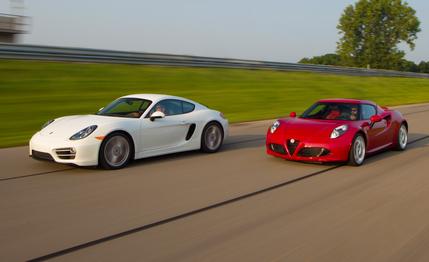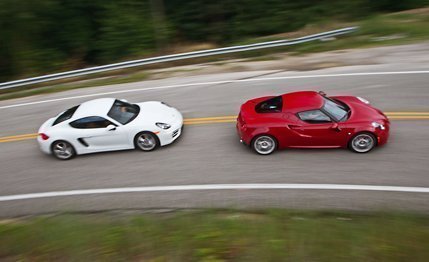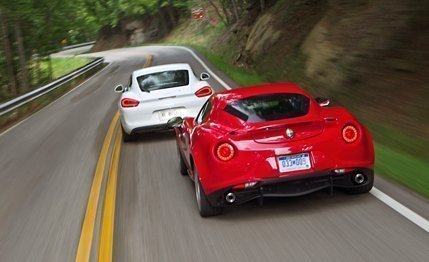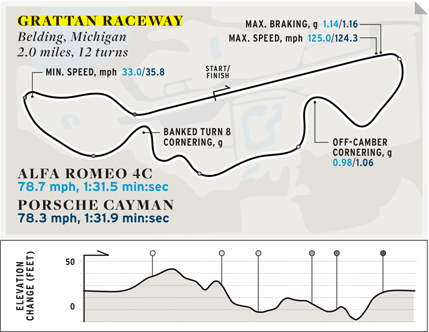 Comparison Tests
Comparison Tests
Do your tax returns routinely trigger DEFCON alerts at the IRS? Are your personal finances cited in biz-school case studies of the filthy rich? If so, please skip this story. This comparison test is for sports-car enthusiasts of somewhat lesser means—those with Moët tastes and, well, a Moët budget, once in a while, if the kids are already out of college.
After years of threatening a comeback and delivering a few 8C moon rocks, Alfa Romeo has resumed shipping cars to America. If images of star-crossed Milano sedans or Benjamin Braddock from The Graduate come to mind, you’re way overdue for a software upgrade. The Alfa 4C challenging Porsche’s second-generation Cayman in this test is a legit exotic with a base price barely above that of a Corvette Stingray.
In pitting this tantalizing newbie against the reigning authority in the affordable mid-engine sports-car class, we logged 650 miles, hot-lapped a challenging racecourse, and subjected the cars to a full work-up of performance tests. As always, our goal is to identify the better all-arounder, not the quicker quarter-mile sprinter or the superior track car.

For our real-world driving portion, we scouted fresh (to us) northeastern Kentucky roads. This is coal country, where pickup-truck brands create tribal affiliations and rebel flags fly. To extract coal, mining companies simply blow the tops off Appalachian Plateau foothills. Laying pavement through this region also required deep cuts into mountainsides. We blitzed 66 miles of pristine Kentucky Route 32 between Morehead and Louisa, a dizzying mix of switchbacks and sweepers with more elevation changes than Six Flags’s Kingda Ka coaster. Traffic and enforcement were blissfully light.
The Cayman is the sports car that Dr. Porsche and his son first dreamed of building in 1939; two seats under a sleek roof, with the engine in the middle and the suspension cinched tight. In case you slept through physics class, a mid-engine layout enhances acceleration, braking, and handling dynamics with optimum tire loading and a low polar moment of inertia [“Location, Location,” July 2011].
A $53,595 Cayman starting price buys you an aluminum-intensive body, a 275-hp 2.7-liter flat-six, and 18-inch wheels and tires. Adding a $4690 infotainment package, $2320 power sport seats, $1790 adjustable dampers, $1560 19-inch wheels and tires, a $1320 brake-based torque-vectoring system, and a few other options bumped the Porsche’s as-tested price to $70,345.

The Alfa Romeo 4C is for all intents a cub Ferrari 458 Italia. Aping the blank-check mid-engined sports cars offered by Ferrari, Lamborghini, and McLaren, the 4C’s core is a carbon-fiber-composite tub that weighs only 235 pounds. A new 1.7-liter inline-four engine boasts aluminum-block-and-head construction, an over-square bore/stroke ratio, forged internal parts, and direct fuel injection.
A BorgWarner turbo adds 21 psi of boost, and an intercooler dumps unwanted heat into the atmosphere. The 4C’s 237 horsepower doesn’t sound that impressive until you factor in its 2471-pound curb weight, a 609-pound advantage over the Cayman. Its wheelbase is shorter than the Porsche’s by 3.7 inches, with 14.9 less inches of overall length.

Adding nearly every available option inflated a $55,195 base 4C into our $68,495 test car. Extras included a $2750 leather package, a $2400 Track package, $3000 18- and 19-inch wheels with stickier summer tires, an $1800 Convenience package, $1000 red leather seats, a $500 racing exhaust, and $1850 for other nonessentials, such as a battery tender, bixenon headlamps, and Rosso Alfa paint. The only available transmission is a six-speed dual-clutch automatic.
Here’s what we learned when we put both cars in the ring.